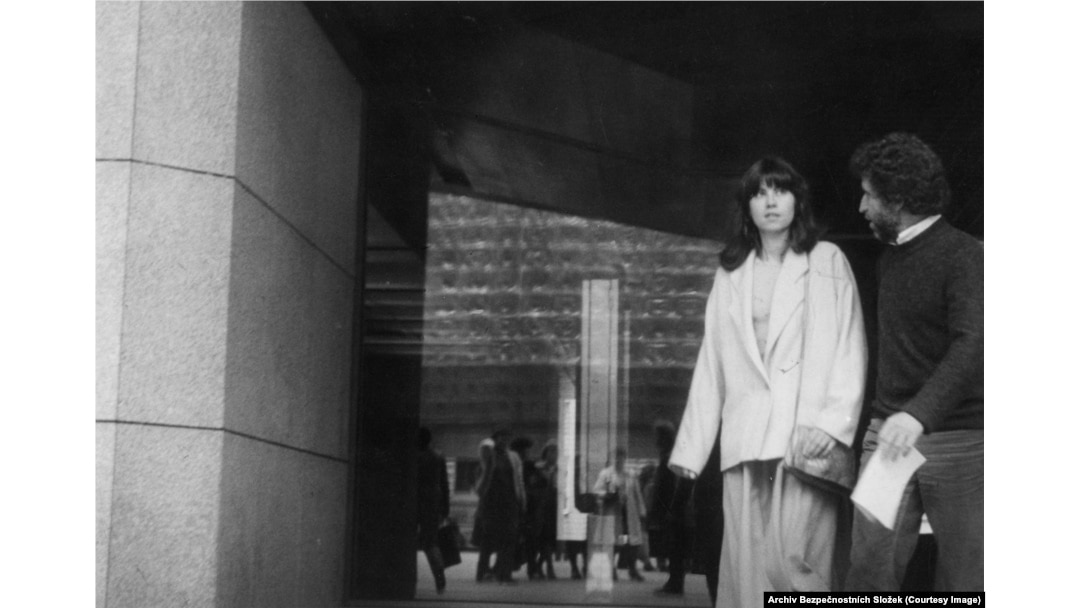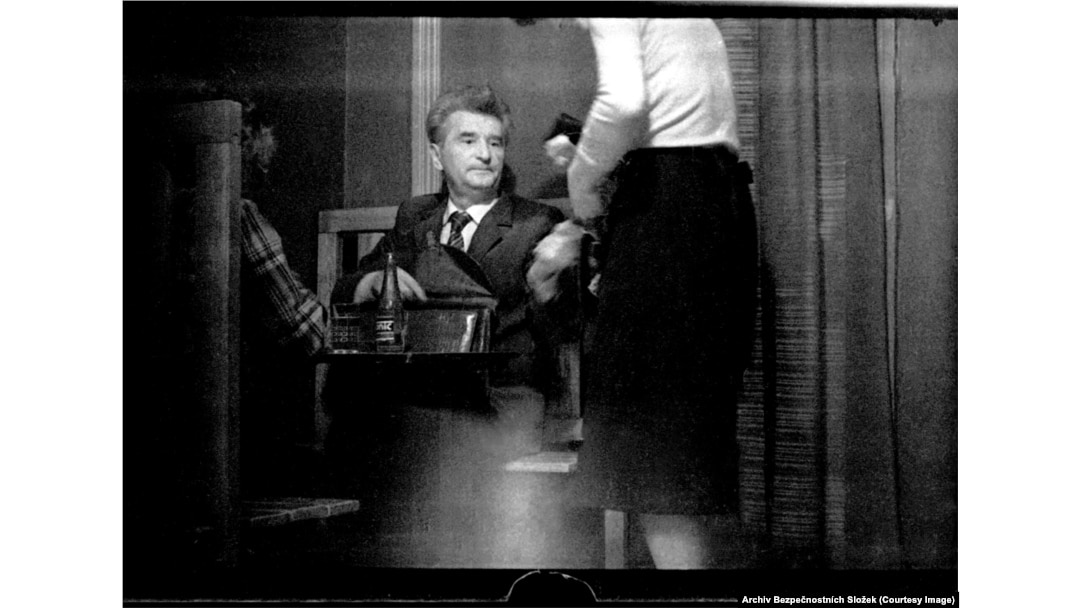
A young woman, lost in thought, strolling through downtown Prague.

A couple on a winter’s day near Prague’s National Theater. They are Dagmar and Ivan Havel, the brother of dissident Vaclav Havel who became the president of Czechoslovakia and the Czech Republic.

A man pays for drinks after meeting with a friend in a gloomy Prague wine bar.
These are some of the thousands of images snapped by Czechoslovakia’s secret police during the 1970s and '80s using tiny hidden cameras.
Czechoslovakia at the time was in the “normalization period” that followed the 1968 invasion of the country by Soviet-led forces. The military takeover was ordered by the Kremlin after Czechoslovakia’s government attempted to ease restrictions on speech and implement other political reforms. For ordinary citizens, “normalization” meant a revived effort by the regime to assert extreme police control.
The Mikroma camera, developed in Czechoslovakia in 1949. The camera measures 7.5 centimeters from end to end – about the length of a cigarette lighter. It was the first miniature camera model used by the country’s secret police.
One of the favorite tools of the communist police were miniature cameras, often hidden in briefcases, used to document what they called “enemy activity.” In reality, this usually meant critics of the regime were photographed as they were going about their daily lives.
Czechoslovak author Milan Kundera (right) speaks with an associate. A 2008 book called Prague Through The Lens Of The Secret Police – from which many of these images are sourced -- identifies the leather-jacketed man in background as an agent operating a camera hidden in his suitcase. The spy cameras could be triggered with a thin cable, allowing pictures to be taken without touching the device itself.
The same scene as shot by the leather-jacketed agent. Another man holding a briefcase, possibly the second photographer, lingers near Kundera.
Czechoslovakia’s totalitarian police network also went to elaborate lengths to capture video footage of targets.
This baby carriage conceals a high-end video camera.
The camera is mounted at the front corner of the baby carriage.
The opening for the camera’s lens can be seen at far right. The pram was operated by two agents who acted as a married couple.
Two men chatting at the entrance of a church near Prague Castle.
Anti-communist dissident Vaclav Havel (front left) seen leaving the Canadian Embassy with his brother Ivan, who wears a patterned tie.
Harold Gordon Skilling, a Canadian academic with links to opposition groups in Czechoslovakia. Skilling was among the foreigners followed by secret police while visiting the country.
Men waiting at a tram stop.
These chilling images are now held at the Czech Republic’s Security Services Archive in Prague.
Stacks of files in the Security Services Archive, which is housed near the Vltava River.
A folder in the archive titled “OBSERVATION.”
One folder that RFE/RL was given access to contains a photograph of Mother Teresa (second from right) arriving at Prague’s airport in 1984. Notes in her file say the secret police wanted to document who greeted the famous Catholic nun when she entered the country.
Many files in the archive are dedicated to religious workers like these two Prague nuns. Devout Christians were seen by the regime as an untameable threat.
Czechoslovakia’s secret police were particularly obsessed with the dissident Alena Hromadkova (pictured above on Prague’s Wenceslas Square). They stalked her for four years.
Reports on Hromadkova’s activities include detailed descriptions of her clothing. On January 5, 1984 an agent reported: “She was wearing an off-white fur cap, a dark cinnamon-colored coat, a long black scarf around her neck, green trousers, and white sports shoes…”
Some reports reveal the extraordinary lengths agents went to in order to record potentially compromising information. One “tail” operation by secret agents racked up a bill for several beers and meals as they followed a well-known musician through a night out. Their report described the musician “speaking loudly” with a group of friends outside a bar at 1:15 a.m. before he and a young woman “went behind a fence next to the Maj department store…”
Jiri Hajek (right), who had been Czechoslovakia’s foreign minister until his dismissal for speaking out against the 1968 Soviet-led invasion, was photographed as he met with a contact.
The unidentified man strides away from his meeting with Hajek.
A young woman pulls her coat close as she passes a clandestine agent with a camera in downtown Prague.
A child appears to notice an agent secretly photographing her mother.
Although imprisoning dissidents was less common by the 1980s, the regime could easily ruin people professionally by making them unemployable in their fields, and blocking entry to universities for their “enemy” children.
In some photographs, people appear to suspect the agents who are stalking them.
These men laugh openly at an agent attempting a stealthy street snap.
Other images apparently miss their target, but capture evocative moments like this photo in Prague’s Old Jewish Cemetery.
A street scene in Prague as the communist world in Europe was beginning to unravel.
Vaclav Havel (right) speaks with his friend Jiri Dienstbier. The two suffered decades of persecution from communist authorities. Havel spent several years in prison. Dienstbier was fired from his job as a journalist and resorted to working as a janitor for 20 years after the 1968 Soviet-led invasion. After the 1989 Velvet Revolution that overthrew communist rule, Dienstbier became Czechoslovakia’s foreign minister and Havel became president.
In 2003, a list of 75,000 people who worked for or collaborated with Czechoslovakia’s secret police was released to the public.


